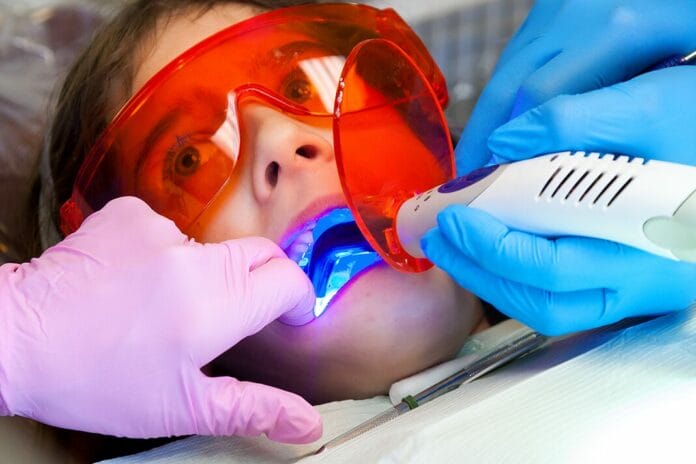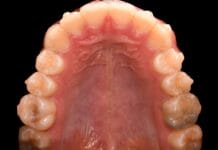Dental sealants are a highly effective method for preventing dental caries in children and adolescents who are at higher risk of developing dental caries. When properly applied on the first and second molars, especially those with deep pits and fissures, sealants significantly decrease the likelihood of caries formation on these teeth.1
Since sealants are proven to prevent and arrest (non-cavitated) pit and fissure occlusal caries in molars, Healthy People 2030 aims to increase the number of children and adolescents with dental sealants on at least one molar to 42.5%. Despite this objective from the U.S. Department of Health and Human Services, only 37% of children and adolescents aged three to 19 had received dental sealants during the reporting period of 2013 to 2016, regardless of their caries risk.1
A recently published study in the Journal of the American Dental Association aimed to assess the effects of a clinical decision support system in improving the number of sealants placed in high-risk children and adolescents.1
The Study
Dental quality measures (DQMs) are tools that assess and analyze the performance of a practice, population, or individual care provider. They can reveal trends, inconsistencies, and disparities in care that can be acted upon at the end of the measurement period. However, in this study, a group of oral health professionals and informatics analysts utilized a DMQ for dental sealant placement into a per-visit measure to evaluate each patient’s need for sealants during their visits.1
The DQM assessed if patients with sealable teeth received a sealant during the annual reporting period. This logic was adapted to automatically determine a patient’s suitability for sealants at each exam to aid clinical decision-making during visits using a clinical decision support system (CDSS). A CDSS helps provide actionable information at the point of care to make it easier to provide the right care through improvements, such as mitigating medical errors, improving patient safety through reminder alerts, and increasing adherence to clinical guidelines.1
The CDSS identified patients aged five to 15 with a moderate, high, or extreme caries risk assessment (CRA) and assessed each case for sealant-eligible teeth. Sealant-eligible teeth were identified from electronic health record (EHR) data as any fully erupted first or second permanent molars that had not been previously sealed, treated, planned for treatment, or diagnosed with caries.1
Exclusions included teeth with class V buccal or facial surface restorations, endodontic procedures (i.e., pulpotomy or root canal therapy), extractions, or fixed prosthodontic procedures that were either completed or planned. Active caries diagnosis excluded buccal and facial surface caries only, as these should not prevent sealant placement in the absence of occlusal caries or procedures.1
During routine recall visits, the CDSS alerted the clinical care team about the need for dental sealants for children meeting the age and elevated CRA criteria with at least one sealant-eligible tooth. The CDSS operated as a passive checklist of process and disease-prevention tasks for the care team to review and complete at each visit.1
The checklist automatically updated from EHR data as tasks were completed and included measures to ensure the completion of CRA, “base” charting (including dentition, existing restorations, and findings), and planned procedures recorded with a dental diagnosis. Overall, the clinical providers routinely completed over 98% of these process measures.1
The process measures were supplemented with a quality improvement score (QIS) that included prevention metrics for the completion of sealants and fluoride treatments. Data from pediatric examination visits over five years (January 1, 2018, to December 31, 2022) were extracted directly from the EHR database.1
The CDSS for sealant placement was implemented in September 2020, providing 32 months of pre-implementation data and 28 months of post-implementation data for comparison. The rates of sealant placement, calculated as a percentage of sealant-eligible examination visits for children with elevated CRA, were compared before and after the implementation of the CDSS.1
Results
This study spanned nearly 50 clinics across Oregon, Washington, and Idaho over five years from January 1, 2018, to December 31, 2022. In total, 59,047 examination visits were assessed, with 33,640 visits occurring before the CDSS implementation and 25,407 visits after.1
The results showed a significant improvement in compliance with evidence-based guidelines for appropriate sealant placement across the entire organization after the CDSS was introduced in September 2020. Before the implementation, appropriate sealant placements at recall visits averaged below 30%. This rate increased to over 55% in the month following the CDSS implementation and consistently remained above 60% thereafter.1
As a result of this improved rate of appropriate sealant placements at examination visits, over 7,500 children at elevated risk of caries received sealants during the 28 months following the CDSS implementation, who might not have received them without the tool.1
Conclusion
Various obstacles to the proper placement of sealants and adherence to guidelines have been identified, ranging from private practices to large group practices. For providers, these barriers include personal clinical experiences, liability concerns, lack of understanding of standards of practice, unawareness of expectations, and attitudes and knowledge about sealants.1
The next steps in the quality improvement cycle involve gathering and interpreting feedback from providers and patients, monitoring the success of the same-day sealant intervention, identifying specific initiatives to address, and adjusting training and ongoing refinement of the CDSS as necessary. One consideration is finding ways to maintain the benefits of the passive CDSS that providers do not find inconvenient and disruptive to workflow while making it more visible and accessible to enhance the rates of appropriate care.1
With ongoing improvements in preventive service delivery, further assessment of patient health outcomes, such as reduced caries risk and fewer new caries, will be conducted to demonstrate the overall impact of increased appropriate sealant delivery. An effective CDSS for sealant placement can be integrated into a dental quality improvement program to successfully implement evidence-based guidelines, thereby facilitating and enhancing timely and appropriate patient care delivery.1
Before you leave, check out the Today’s RDH self-study CE courses. All courses are peer-reviewed and non-sponsored to focus solely on high-quality education. Click here now.
Listen to the Today’s RDH Dental Hygiene Podcast Below:
Reference
- Mullins, J., Brandon, R., Skourtes, N., et al. Improvements in Appropriate Placement of Dental Sealants After Implementation of a Clinical Decision Support System. J Am Dent Assoc. 2024; 155(5): 409-416. https://www.ncbi.nlm.nih.gov/pmc/articles/PMC11156465/












